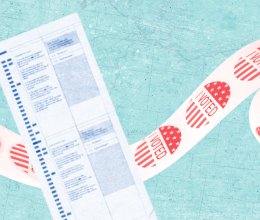Three blind individuals and the National Federation of the Blind, Inc. sued the Ohio Secretary of State in the federal district court for the Southern District of Ohio under the Americans with Disabilities Act (ADA). Plaintiffs claimed that the Secretary denied them equal access to absentee voting by refusing to provide an online ballot-marking tool on his website that would allow blind voters to mark their absentee ballots electronically. This tool, which is available as open source technology, is used by other states. Without this accommodation, blind voters cannot mark absentee ballots privately or independently, while sighted voters can do so. The District Court granted the Secretary of State’s motion for judgment on the pleadings, resulting in dismissal of this claim from the case. The Court reasoned that because the software requested by Plaintiffs was not yet “certified” pursuant to a state procedural requirement, its adoption would constitute a “fundamental alteration” of Ohio’s voting system that the ADA does not compel. Plaintiffs filed a notice of appeal to the Sixth Circuit on February 24, 2017.
Legal Theory
First, the District Court’s decision permits the Secretary to discriminate against blind voters, and could have far-reaching implications for voters with other types of disabilities. Furthermore, it was improper for the Court to elevate Ohio’s certification requirement for auxiliary voting aids over the ADA’s requirement of nondiscrimination, as federal law preempts state law. Finally, the lower court should not have dismissed the plaintiffs’ claim on the pleadings alone because the ADA requires fact-sensitive inquiries as to whether an accommodation is required.
Status Update
Plaintiffs/appellants filed their brief on April 12, 2017. Oral argument was requested. On April 17, 2017, we filed an amicus brief in the Sixth Circuit, jointly with ACLU’s National Disability Rights Program, our fellow ACLU affiliates in this Circuit (i.e. Michigan, Tennessee and Kentucky), and other disability rights advocates. Defendant filed his response on May 10, and Plaintiffs filed their reply brief on May 24. Oral arguments were held on October 12, 2017. On November 13, 2017, the Court issued a decision reversing the district court’s ruling and remanding the case for discovery and trial on the merits. On December 6, 2017, the mandate issued.
On December 13, 2017, the Court held a status conference, during which parties agreed to take part in settlement discussions. The Court ordered all discovery completed by March 30, 2018. On December 14, 2017, Plaintiffs filed a motion requesting that the Court shorten discovery and set a trial date, citing urgency for the case to be resolved before the November 2018 election. On December 15, the Court denied Plaintiffs’ motion, writing that a trial date would be set after further analysis of the case, including what specific issues remain to be resolved following the Sixth Circuit decision.
On December 19, 2017, Judge Smith recused himself and the case was reassigned to Judge Graham. The Court held telephonic conferences on January 4 and January 29, 2018. During the second conference, Defendant informed the Court that he had issued a directive ordering all county boards of elections to implement a certified electronic absentee ballot-marking tool before the November, 2018 general election.
Plaintiffs agreed that this directive may moot their remaining claim, but indicated they want to confirm that Defendant’s implementation process would comply with the ADA prior to dismissing the claim. The parties submitted a Joint Status Report on March 1. In the Report the parties indicated they had begun informal discussions regarding Plaintiffs’ claim for attorney fees and costs, and Defendant’s implementation of the absentee ballot marking tool. On March 30 Parties filed a second joint status report, indicating they had reached an agreement as to fees and costs and were close to reaching an agreement as to implementation of the absentee ballot-marking tool, and requesting an additional 30 days to finalize the settlement. On April 30 Parties filed a third joint status report, requesting an additional 14 days to come to an agreement regarding implementation. On May 14 Parties filed a fourth joint status report informing the Court they had reached an agreement, and on June 11 filed a Stipulated Dismissal.





